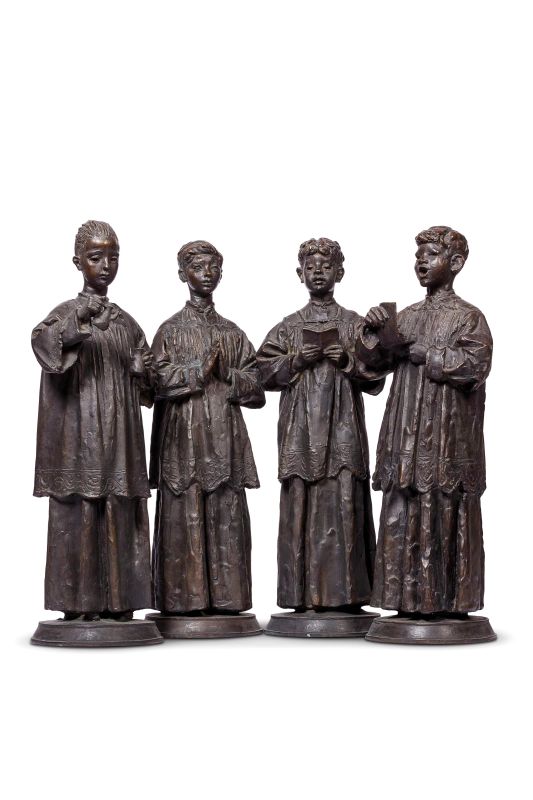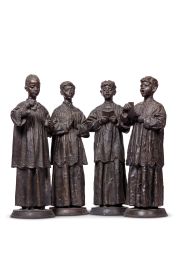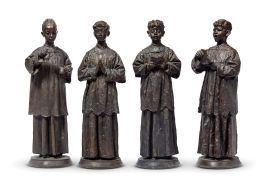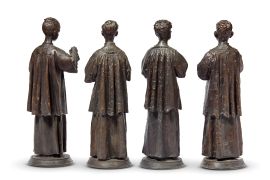Francesco Messina © (Linguaglossa, 1900 - Milano, 1995)
Francesco Messina
Francesco Messina
(Linguaglossa 1900 - Milano 1995)
QUATTRO CHIERICHETTI
1950 circa
firmati
bronzo
alt. cm 58,5
FOUR ALTAR BOYS
circa 1950
signed
bronze
h. 23 in
Bibliografia
G. Bazin, Francesco Messina, Milano 1966, tavv. 132-135.
N. Loi, A. Pasolucci, A. Fiz, P.B. Conti Piccone, Francesco Messina, mostra celebrativa per i 90 anni, Torino 1991, tavv. XLIV-XLV.
I quattro personaggi in bronzo, databili attorno al 1950, sembrano reinterpretare un verismo classicista di sapore tardo ottocentesco napoletano, in richiamo al linguaggio e alla maniera di Vincenzo Gemito. È noto quanto la cultura visiva di Francesco Messina avesse risentito di una certa persistenza della tradizione ottocentista e dell'estetica proprio dello scultore napoletano, nel caso specifico, dal quale trae ispirazione per i suoi lavori incentrati sulle tematiche dei fanciulli. Ognuno dei giovinetti è realizzato mediante una profonda e attenta caratterizzazione fisiognomica, con precise gestualità e mimiche facciali sempre diverse, nell'intento di descrivere un determinato momento dell’attività del chierichetto nel corso della celebrazione liturgica. Sintetica è la classicità che traspare dal modellato, dai volumi esatti e levigati dei soggetti; analitica è, invece, la resa preziosa e cesellata dei dettagli delle vesti, in un panneggio che rivela, in ogni sua piega, una certa ricerca chiaroscurale nel procedimento scultoreo, alla maniera gemitiana.
In their references to the language and the manner of Vincenzo Gemito, these four bronzes, datable to about 1950, seem to reinterpret a classicistic Verism with a late-19th-century, Neapolitan feel. It is well known how much Francesco Messina’s visual culture was influenced by a certain persistence of the 19th-century tradition and the Neapolitan sculptor’s aesthetic, from which he drew inspiration for those of his works centred on the themes of youth. The characterisation of each of the boys is individually and carefully crafted; the gesture and facial expression of each is profoundly different from any of the others; the intention is to describe single moments in the boys’ activities during the liturgical celebration. The classicism betrayed by the modelling, by the exact and polished volumes of the subjects, is synthetic; analytic, instead, the precious, chiselled rendering of the robes, of the draped fabric, every fold of which reveals a search for chiaroscuro effects in the sculptural process which is, again, highly reminiscent of Gemito.






